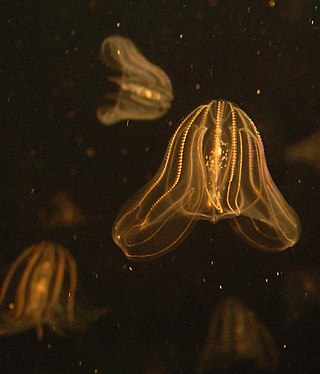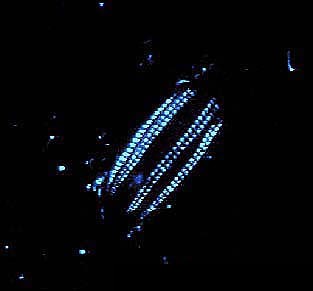At the end of each Major League Baseball season, the league leaders of various statistical categories are announced. Leading either the American League or the National League in a particular category is referred to as a title.

Beroidae is a family of ctenophores or comb jellies more commonly referred to as the beroids. It is the only family within the monotypic order Beroida and the class Nuda. They are distinguished from other comb jellies by the complete absence of tentacles, in both juvenile and adult stages. Species of the family Beroidae are found in all the world's oceans and seas and are free-swimmers that form part of the plankton.
This is a list of players, both past and current, who appeared at least in one game for the Detroit Tigers, with their main position and years played.

Chrysaora is a genus of jellyfish, commonly called the sea nettles, in the family Pelagiidae. The origin of the genus name Chrysaora lies in Greek mythology with Chrysaor, brother of Pegasus and son of Poseidon and Medusa. Translated, Chrysaor means "he who has a golden armament."

Ocyropsis is a genus of Ctenophores, which are commonly known as Comb Jellies. Ocyropsis belong to the family of Ocyropsidae. Ocyropsis possesses two large lateral muscular lobes and four auricles, and appear pale and translucent in color. Ocyropsis habitat is not precise as their gelatinous composition can make it difficult to study. They have been found in warm and cold waters. Unlike other, slow swimming Ctenophores, Ocyropsis are efficient in evading their predators. They use their oral lobes for additional propulsion and a secrete luminous mucous in efforts to evade predators. The muscular oral lobes of the Ocyropsis are used to grab its prey, and then moved to the prehensile mouth for absorption.

Cyanea is a genus of jellyfish, primarily found in northern waters of the Atlantic and Pacific Oceans and southern Pacific waters of Australia and New Zealand, there are also several boreal, polar, tropical and sub-tropical species. Commonly found in and associated with rivers and fjords. The same genus name has been given to a genus of plants of the Hawaiian lobelioids, an example of a parahomonym.

Bolinopsidae is a family of ctenophores.

Cucumariidae is a family of sea cucumbers, marine animals with elongated bodies, leathery skins and tentacles that are found on the sea bed.

Aequorea is a genus of pelagic hydrozoans in the family Aequoreidae.

Leucothea is a genus of ctenophores in the monotypic family Leucotheidae.
Coeloplana loyai is a species of benthic comb jelly. It is known from the Red Sea and lives as an episymbiont on the mushroom corals Herpolitha limax and Ctenactis echinata. It can be differentiated from congeneric species by their host, colour, and colour pattern.
Coeloplana yulianicorum is a species of benthic comb jelly. It is known from the Red Sea and lives as an episymbiont on the soft coral Sarcophyton yulianicorum. It can be differentiated from congeneric species by their host, colour, and colour pattern.
Coeloplana huchonae is a species of benthic comb jelly. It is known from the Red Sea and lives as an episymbiont on the stems of the soft coral Dendronephthya hemprichi. It can be differentiated from its congeneric species by their host, colour, and colour pattern.
Coeloplana fishelsoni is a species of benthic comb jelly. It is known from the Red Sea and lives as an episymbiont on colonies of Xenia umbellata and Paralemnalia species. It can be differentiated from its congeneric species by their host, colour, and colour pattern.

Euplokamis is a genus of ctenophores, or comb jellies, belonging to the monotypic family Euplokamididae. It shares the common name sea gooseberry with species of the genus Pleurobrachia. Despite living for hundreds of millions of years in marine environments, there is minimal research regarding Euplokamis, because they are uncommon. Research on the evolution of the basic body structures of diploblastic metazoans revealed that there are four major phyla, including the Ctenophores. Although the morphology of Euplokamis often resembles the medusa stage of Cnidarians, their eight rows of combs are one distinguishing feature that led to the official classification of Ctenophores. After being originally described by Chun (1879), the family Euplokamididae was expanded by Mills (1987) due to the discovery of a new species, Euplokamis dunlapae. Further research indicated that Euplokamis should be identified from Mertensiidae due to the rows of combs and some compression. They may also be distinguished from the genus Pleurobrachia due to their more elongated shape. Additionally, various adaptations of Euplokamis have been observed such as the use of tentacles for movement/feeding, a complex nervous system, and bioluminescent capabilities. Other characteristics including a defined mesoderm, lack of stinging cells, developmental differences, and symmetry supported the reclassification of these organisms.

Coeloplana meteoris, is a species of benthic comb jelly native to the Indo-Pacific region that has also been found in the Arabian-Persian gulf.










